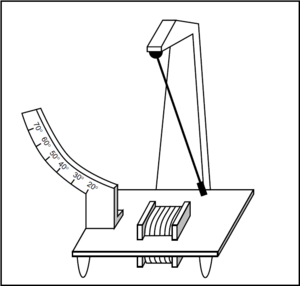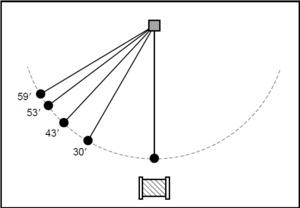Doubochinski's pendulum facts for kids
Doubochinski's pendulum is a cool science experiment that shows how a swinging object, like a pendulum, can be affected by a magnetic field. Imagine a regular pendulum, which is just a weight swinging back and forth on a string or rod. Now, add a small magnet to the end of that pendulum. Underneath it, you place a special magnet called an electromagnet. This electromagnet isn't always on; it gets its power from an alternating current, which means the electricity flows back and forth very quickly.
This amazing setup was first discovered by two brothers, Danil and Yakov Doubochinski, back in 1968–69. They found that when the pendulum swings near the electromagnet, its movement changes in a surprising way. Instead of just swinging freely, the pendulum will eventually settle into a specific height, and this height depends on how fast the electromagnet's current is switching on and off (its frequency). It's like the electromagnet is "catching" the pendulum at certain energy levels!
Contents
What is a Pendulum?
A pendulum is a simple device that swings back and forth. Think of a clock pendulum or a swing set. It usually has a weight, called a "bob," hanging from a pivot point. When you pull the bob to one side and let it go, gravity pulls it down, and its own momentum carries it up the other side. This back-and-forth motion is called an oscillation.
- Pendulums are used in many things, like clocks, to keep time.
- The time it takes for a pendulum to swing back and forth once is called its "period."
- The period depends on the length of the pendulum, not how heavy the bob is.
How Does the Doubochinski Pendulum Work?
The Doubochinski pendulum adds a special twist to a normal pendulum. It uses a magnet on the pendulum and an electromagnet below it.
The Electromagnet's Role
An electromagnet is a temporary magnet. It becomes magnetic only when an electric current flows through it. In the Doubochinski experiment, the electromagnet is powered by an alternating current (AC). This means the electricity changes direction very quickly, usually many times per second. This rapid change creates a magnetic field that turns on and off, or flips its direction, at a very high frequency (from 10 to 10,000 Hz).
- When the pendulum swings, the magnet on its end interacts with the changing magnetic field of the electromagnet.
- This interaction is like a tiny push or pull that happens at specific moments.
Quantized Amplitudes Explained
One of the most interesting things about the Doubochinski pendulum is that it shows "quantized amplitudes." What does this mean?
- Normally, if you let a pendulum swing, it will eventually slow down and stop because of air resistance and friction.
- But with the electromagnet, the pendulum doesn't just stop anywhere. It settles into specific, stable heights or "amplitudes" of its swing.
- It's like the pendulum can only choose from a few special "energy levels" or swing heights, rather than any height at all.
- The exact height it settles at depends on the frequency of the electromagnet's current. If you change the frequency, the pendulum might jump to a different stable height.
Why is This Experiment Important?
The Doubochinski pendulum is important because it helps scientists understand how energy can be transferred and stored in systems that interact with changing forces. It's a simple way to see complex physics ideas, like how energy can be "quantized" (meaning it exists in specific packets or levels) in some situations. This concept is very important in fields like quantum mechanics, which studies the tiny world of atoms and particles.
- It shows how a small, continuous push from the electromagnet can lead to very specific, stable motions.
- It's a great example of how seemingly simple systems can show surprising and complex behaviors.



